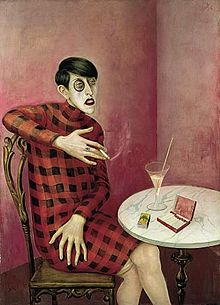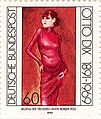- Otto Dix
-
For the Russian band, see Otto Dix (band).
Otto Dix 
Otto DixBirth name Wilhelm Heinrich Otto Dix Born 2 December 1891
Untermhaus (Gera), GermanyDied 25 July 1969 (aged 77) Nationality German Field Painting, Printmaking Wilhelm Heinrich Otto Dix (German pronunciation: [ˈvɪlhɛlm ˈhaɪnʁiç ˈɔto ˈdɪks]; 2 December 1891 – 25 July 1969) was a German painter and printmaker, noted for his ruthless and harshly realistic depictions of Weimar society and the brutality of war. Along with George Grosz, he is widely considered one of the most important artists of the Neue Sachlichkeit.
Contents
Biography
Early life and education
 Otto Dix House in Gera. The artist's birthplace opened as a museum in 1991
Otto Dix House in Gera. The artist's birthplace opened as a museum in 1991
Otto Dix was born in Untermhaus, Germany, now a part of the city of Gera. The eldest son of Franz and Louise Dix, an iron foundry worker and a seamstress who had written poetry in her youth, he was exposed to art from an early age. The hours he spent in the studio of his cousin, Fritz Amann, who was a painter, were decisive in forming young Otto's ambition to be an artist; he received additional encouragement from his primary school teacher.[1] Between 1906 and 1910, he served an apprenticeship with painter Carl Senff, and began painting his first landscapes. In 1910, he entered the Kunstgewerbeschule in Dresden (Academy of Applied Arts), where Richard Guhr was among his teachers.
World War I service
 Stormtroops Advancing Under Gas, etching and aquatint by Otto Dix, 1924
Stormtroops Advancing Under Gas, etching and aquatint by Otto Dix, 1924
When the First World War erupted, Dix enthusiastically volunteered for the German Army. He was assigned to a field artillery regiment in Dresden. In the fall of 1915 he was assigned as a non-commissioned officer of a machine-gun unit in the Western front and took part in the Battle of the Somme. In November 1917, his unit was transferred to the Eastern front until the end of hostilities with Russia, and in February 1918 he was stationed in Flanders. Back in the western front, he fought in the German Spring offensive. He earned the Iron Cross (second class) and reached the rank of vizefeldwebel. In August of that year he was wounded in the neck, and shortly after he took pilot training lessons. He was discharged of service in December 1918.[2]
Dix was profoundly affected by the sights of the war, and would later describe a recurring nightmare in which he crawled through destroyed houses. He represented his traumatic experiences in many subsequent works, including a portfolio of fifty etchings called Der Krieg, published in 1924.
Post-war artwork
 Portrait of the Journalist Sylvia von Harden, 1926, mixed media on wood, 120 x 88 cm, Paris, Musée National d'Art Moderne
Portrait of the Journalist Sylvia von Harden, 1926, mixed media on wood, 120 x 88 cm, Paris, Musée National d'Art Moderne
At the end of 1918 Dix returned to Gera, but the next year he moved to Dresden, where he studied at the Hochschule für Bildende Künste. He became a founder of the Dresden Secession group in 1919, during a period when his work was passing through an expressionist phase. In 1920 he met George Grosz and, influenced by Dada, began incorporating collage elements into his works, some of which he exhibited in the first Dada Fair in Berlin. He also participated in the German Expressionists exhibition in Darmstadt that year.[3]
In 1924 he joined the Berlin Secession; by this time he was developing an increasingly realistic style of painting that used thin glazes of oil paint over a tempera underpainting, in the manner of the old masters. His 1923 painting The Trench, which depicted dismembered and decomposed bodies of soldiers after a battle caused such a furor, the Wallraf-Richartz Museum hid the painting behind a curtain. In 1925 the then-mayor of Cologne, Konrad Adenauer, cancelled the purchase of the painting and forced the director of the museum to resign.
Dix was a contributor to the Neue Sachlichkeit exhibition in Mannheim in 1925, which featured works by George Grosz, Max Beckmann, Heinrich Maria Davringhausen, Karl Hubbuch, Rudolf Schlichter, Georg Scholz and many others. Dix's work, like that of Grosz—his friend and fellow veteran—was extremely critical of contemporary German society and often dwelled on the act of Lustmord, or sexual murder. He drew attention to the bleaker side of life, unsparingly depicting prostitution, violence, old age and death.
Among his most famous paintings are the triptych Metropolis (1928), a scornful portrayal of depraved actions of Germany's Weimar Republic, where nonstop revelry was a way to deal with the wartime defeat and financial catastrophe,[4] and the startling Portrait of the Journalist Sylvia von Harden (1926). His depictions of legless and disfigured veterans—a common sight on Berlin's streets in the 1920s—unveil the ugly side of war and illustrate their forgotten status within contemporary German society, a concept also developed in Erich Maria Remarque's All Quiet on the Western Front.
World War II and the Nazis
When the Nazis came to power in Germany, they regarded Dix as a degenerate artist and had him sacked from his post as an art teacher at the Dresden Academy. He later moved to Lake Constance in the south west of Germany. Dix's paintings The Trench and War cripples were exhibited in the state-sponsored Munich 1937 exhibition of degenerate art, Entartete Kunst. They were later burned.
Dix, like all other practicing artists, was forced to join the Nazi government's Reich Chamber of Fine Arts (Reichskammer der bildenden Kuenste), a subdivision of Goebbels' Cultural Ministry (Reichskulturkammer). Membership was mandatory for all artists in the Reich. Dix had to promise to paint only inoffensive landscapes. He still painted an occasional allegorical painting that criticized Nazi ideals.[5]
In 1939 he was arrested on a trumped-up charge of being involved in a plot against Hitler (see Georg Elser) but was later released.
During World War II Dix was conscripted into the Volkssturm. He was captured by French troops at the end of the war and released in February 1946.
Later life and death
Dix eventually returned to Dresden. After the war most of his paintings were religious allegories or depictions of post-war suffering, including his 1948 Ecce homo with self-likeness behind barbed wire. Otto Dix died in Singen, Germany, in 1969.
Gallery
-
Otto Dix postage stamp, Germany, 1991, reproducing Portrait of the Dancer Anita Berber, 1925
-
Painting of Herbert Eulenberg by Otto Dix, 1922
See also
Notes
- ^ Karcher 1988, pp. 21–24.
- ^ Norbert Wolf, Uta Grosenick (2004), Expressionism, Taschen, p. 34. ISBN 3822821268
- ^ Karcher 1988, p. 251.
- ^ Exhibition of "Cabaret" Era Opens at Met Museum, ARTINFO, November 14, 2006, http://www.artinfo.com/news/story/24291/exhibition-of-cabaret-era-opens-at-met-museum/, retrieved 2008-04-23
- ^ Conzelmann, 1959, p. 50
References
- Conzelmann, O., Otto Dix (Hannover: Fackelträger-Verlag, 1959)
- Hinz, Berthold (1979). Art in the Third Reich, trans. Robert and Rita Kimber. Munich: Carl Hanser Verlag. ISBN 0-394-41640-6.
- Karcher, Eva (1988). Otto Dix 1891-1969: His Life and Works. Cologne: Benedikt Taschen. OCLC 21265198
- Michalski, Sergiusz (1994). New Objectivity. Cologne: Benedikt Taschen. ISBN 3-8228-9650-0
- Schmied, Wieland (1978). Neue Sachlichkeit and German Realism of the Twenties. London: Arts Council of Great Britain. ISBN 0-7287-0184-7
External links
Categories:- 1891 births
- 1969 deaths
- People from Gera
- People from Reuss Younger Line
- German painters
- War artists
- Military art
- Modern painters
- Dada
- German Expressionist painters
- German Esperantists
- German military personnel of World War I
- German military personnel of World War II
- Recipients of the Iron Cross
- Commanders Crosses of the Order of Merit of the Federal Republic of Germany
-
Wikimedia Foundation. 2010.




